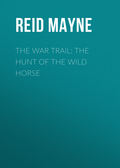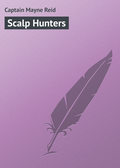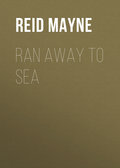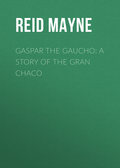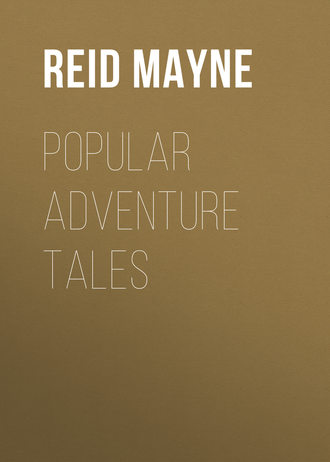
Майн Рид
Popular Adventure Tales
CHAPTER XIV.
THE DESERTED MISSION
That night all went to rest with hope in their hearts, though still not without some anxiety.
If you reflect upon the situation in which they were placed, you will not wonder that they were anxious about the future. Their first care had been to fly into the wilderness, without thinking upon the necessities they might encounter there – without reflecting that they had made no provision of food to sustain them. It is true that in the great Montaña there are many plants and trees whose roots and fruits can be eaten; but a traveller may go for days without finding one of these. Indeed, to pass through this great forest, in most places, is impossible, so completely are the creeping parasites matted and laced together. It is necessary to keep along the rivers in a canoe or raft, else you cannot get from place to place.
You cannot even walk along the banks of many of these rivers, as the underwood hangs into the very water! For the same reason game is hard to be procured, and neither Don Pablo nor Guapo were provided with proper weapons to hunt with. Don Pablo's pistols were all the fire-arms they had, and Guapo had no other weapon than his macheté. With their present means, then, there was very little chance of their killing any game, even should they have fallen in with it. But they saw none as yet, except some birds, such as parrots, macaws, and toucans, that fluttered among the leaves. No wonder, then, they were anxious about what they should find to eat, or whether they should find anything at all.
Don Pablo considered the cross a good omen, or rather a good sign. Some missionary must have planted it in years gone by. No doubt a missionary station must have been near; and it was highly probable that what he had seen in the little valley below would turn out to be the very place where it had stood.
As soon as it became day, therefore, Don Pablo again ascended the tree to take the bearings of the valley, so that they should proceed towards it. Guapo also climbed up, so that both might make sure of the route they ought to take – for in the tangled forests of South America it is no easy matter to reach any object, which you may have only seen at a distance from the top of a tree. Without a compass, the traveller soon loses his direction; and, after hours of vain exertion and devious wandering, often finds himself at the very place from which he had started.
After carefully noting the direction of the valley, Don Pablo and Guapo came down from the tree; and while the former, assisted by Leon, packed and saddled the animals, Guapo was busy with his macheté in clearing away the brushwood that obstructed the path. This did not turn out such a task after all. It was only at the brow of the ridge, where the undergrowth had choked up the way. A little farther down it was quite passable, and the party, animals and all, were soon winding down the Sierra towards the valley. Half-an-hour's travelling brought them to their destination; and then a shout of joy, coming simultaneously from all of them, announced their arrival upon the spot.
What was it that caused them to utter this shout of joy? Before them towered the great musaceæ– plantains and bananas. There were both: their broad yellow-green and wax-like leaves sheathing their succulent stems, and bending gracefully over to a length of twenty feet. But beautiful as were the leaves of these giant plants, more attractive still to the eyes of our travellers were the huge clusters of fruit-pods that hung from beneath them. Each of these would have weighed nearly an hundred-weight! There was food for hundreds. These plants grew by the water's edge, in a damp soil – their natural habitat. Their leaves drooped over the stream. Another plant, equally interesting, was seen farther back, in a dry place. There were many of these ten or fifteen feet high, and as thick as a man's wrist. This was the yucca plant. All of them knew it. They knew that its roots produced the far-famed cassava. Cassava is bread. Hurrah! the staff of life was secure!
But, more than this, there were fruits in abundance; there were mangoes and guavas, oranges and the celebrated cherimoya – the favourite of Peru. There were shaddocks and sweet limes; and see! yonder is a clump of sugar-canes, with their thin silken leaves and yellow tassels waving in the wind. Oh, look here! Here is a coffee-shrub, with its ripe, aromatic berries; and here is the cacao-tree. Coffee and chocolate – there was a choice of beverages! Ha! what have we here – this plant like an orange tree? It is a species of holly. As I live, it is the yerba maté, the “Paraguay tea.” What shall we light upon next?
And so the delighted travellers went on, over the ground, through the thick-tangled weeds and convolvuli, making new discoveries at every step. Even Guapo's favourite, the coca-shrub, was found growing among the rest, and the eyes of the old Indian sparkled at the sight of it.
Don Pablo's first conjecture had been right. They had arrived at the ruin of some old missionary station, long since deserted. Some zealous monk had planted all these plants and trees; had for years, no doubt, tended them with care; had dreamt of establishing around this lonely spot a great hierarchy, and making the “wilderness blossom as the rose.” An evil day had come – perhaps during the revolt of Juan Santos, or maybe in the later revolution of Tupac Amaru. The hand of the savage had been turned against the priest, who had fallen a victim, and his roof – the mission-house – had been given to the flames. Not a vestige of building was to be seen – neither stick nor stone – and had it not been for the curious variety of vegetation collected on the spot, this once cultivated and flourishing garden might have been taken for part of the primeval forest.
It must have been a long time since the place was inhabited, for great trees and parasites had grown up in the midst of the cultivated plants.
After the first transports of delight had to some extent subsided, a consultation was held as to future proceedings. They were not long in coming to a conclusion. It was resolved that a house should be built in the middle of this wild garden, which should be, for a time at least, their home.
The poor llamas had made their last journey. They were to be killed. Guapo, although reluctant to part with his old favourites, knew that they could not live in the warm climate of the valley, and therefore consented. Their flesh, it is true, is none of the best, but it would taste the better that no other was to be had; and their wool and skins would be found useful. The llamas were killed.
CHAPTER XV.
THE GUACO AND THE CORAL SNAKE
It was Guapo himself that killed the llamas, and, having skinned them, he cut the flesh into thin strips, and hung it upon the branches to dry in the sun. This, of course, was necessary, as they had no salt to cure it with; but meat well dried under a hot sun will keep good for a long time. It is curious, that in all Spanish-American countries they preserve most of their meat in this way, whereas in North America, among the people of our own race, “jerked beef” (for that is the name we give it) is very rare.
Now, in Spanish-America there are vast depositories of salt – both in mines and on plains, with salt lakes – called salinas; yet, for want of a proper commercial activity existing among these people, in many places the valuable article, salt, is both scarce and dear. In Mexico dried or “jerked” beef is called “tasajo.” In Peru, as we have stated, it is “charqui;” but mutton cured in this way is distinguished by the name “chalona.” Now as the llamas are a species of sheep, it was “chalona” that Guapo was making out of their mutton.
The others were not idle; Don Pablo, assisted by Leon, was clearing a place on which they intended to build the house, while the Doña Isidora, with her soft slender fingers (for the first time in her life, perhaps), was acting as laundress, and the little Leona assisted her as much as she was able. Where did they get their soap, for they had not brought so much as a single cake along with them?
But Don Pablo was too good a botanist not to know the nature of the trees that grew around, and the uses to which they could be applied. Near by grew a curious tree, which is known among the Indians as the parapara. It was the soap-berry of botanists and Don Pablo knew that the bark of the berries, when rubbed, produces a lather that will wash linen equal to the best “Castile.” Doña Isidora was not long in making a trial of it, and found this to be true. The little round stones of the berries, when cleared of the pulp, are very pretty, and are much used by the missionaries in making rosaries. Leon found, dropping one of them on a stone, that it was as elastic as a ball of India rubber, for it rebounded several times the height of a man's head!
In the evening they all rested from their various occupations, and seated themselves upon the new-cleared ground, upon the trunk of a tree that had been felled. They were one and all quite cheerful. They felt no more apprehension of pursuit. It would have been a very revengeful enemy, indeed, who would have followed them so far into the wilderness. They had no fear of that. Doña Isidora had just cooked a kettle of coffee – they had both pots and kettles, for these were some of the utensils with which Guapo, even in the hurry of flight, had taken the precaution to load his llamas.
This coffee turned out to be of the finest quality. It was of a peculiar species, which has long been cultivated by the missionaries of Peru, and which yields a very high price. It used to be sent by the viceroys as a valued present to the kings of Spain. To sweeten the coffee some joints of sugar-cane had been crushed, and boiled in a rough manner; and for bread they had roasted plantains. During the repast they were all quite merry, and pleasant jokes were passed for the first time in many days.
While thus engaged a singular sound fell upon their ears. It was like a voice repeating the word “Guaco!” They all listened. “Guaco – Guaco!” again came the voice.
“Hola!” cried Leon, “Guapo – Guapo! there's some one calling you, Guapo. There again! – no – it's 'Guaco' – listen! Guaco – Guaco' What is it, I wonder?”
“That's the snake-bird,” quietly answered Guapo, who, it must be remembered, was a native of the Montaña, and knew a great deal both about the birds and beasts of these regions.
“The snake-bird?” exclaimed Leon, evidently interested in the name.
“Yes, young master!” replied Guapo; “look! yonder it goes!”
The eyes of all were instantly turned in the direction pointed out by Guapo. There sure enough was a bird, not much larger than a common pigeon, but which had all the appearance of a sparrow-hawk. It was “swallow-tailed,” however, and this, with its peculiar form and the manner of its flight, showed that it was one of the kite-hawks. When first noticed, it was perched upon the top of a high tree, but it soon flew to another not so high, uttering as it went, the “Guaco – Guaco!” It then pitched itself to a still lower branch, and was evidently after something which none of the party could see. That something, however, soon became apparent. The ground had been cleared in a broad track down to the water's edge, and near the middle of the open space an object was observed in motion, making towards the weeds. That object was a snake.
It was not a large one – not more than three feet in length – and its beautiful body, variegated with bands of black, red, and bright yellow, glistened as it moved. Its predominating colour was a fleshy red, or coral, from whence it has its name, for both Don Pablo and Guapo, as soon as they saw it, pronounced it the “coral snake.” Beautiful as it appeared, all knew that it was one of the most poisonous of serpents – one of the most dreaded of South American reptiles.
The first thought of Guapo and Leon was to spring up, seize upon some weapon, and kill the creature. Don Pablo, however, restrained them.
“Stay where you are,” said he; “be patient; we shall have a scene. Look at the hawk, – see!”
As Don Pablo spoke, the guaco, which had hopped down to the lowest branches of a neighbouring tree, swooped suddenly at the snake, evidently aiming to clutch it around the neck. The latter, however, had been too quick, and coiling itself, like a flash of lightning darted its head out towards the bird in a threatening manner. Its eyes sparkled with rage, and their fiery glitter could be seen even at many yards distance.
The bird diverged from its course, and after passing the snake, turned and swooped again from the opposite direction. But the reptile had shifted its body so as to meet the attack, and its threatening head once more was reared high above its coiled body. The guaco was foiled a second time.
This second failure seemed to enrage the bird, as it turned at shorter intervals, and apparently losing all fear, fluttered over the reptile, striking both with beak and claws. The latter still kept in its coil, but its head moved hastily from side to side, so as always to “show front” to its active antagonist.
After this play had continued for some time, the snake was seen to draw in its head farther than usual, and the hawk, evidently somewhat off his guard, deeming this a fair opportunity, pounced forward to seize it. But he was met half way. The head of the serpent shot forward like a rapier, and reached his breast. The hawk felt that he was wounded; and uttering a wild scream, he flew suddenly away.
All eyes watched him as he flew off, expecting that he would fall – for the bite of the coral snake will kill even a man in a few minutes, and a bird or small animal in much less time. It is not correct to say that all of them expected to see him fall. Guapo, from experience, knew better, and even Don Pablo, as a naturalist, had heard a strange account of this singular bird, and was curious to witness the result. The hawk, therefore, was narrowly watched.
It flew directly for a tree, up against the trunk of which, and clinging to its branches, grew a parasite or creeping plant. The latter was of the thickness of a willow rod, with long slender leaves, of a dark green colour. The bird did not alight upon the top of the tree, but on a branch where it could reach the leaves of the creeper, which it began immediately to pluck and devour. In a short while it had eaten as many as a dozen of these long leaves, when it again took to wing, and flew back in the direction of the snake.
All had, for the moment, forgotten the snake, in their eagerness to watch the movements of the bird. To their astonishment the reptile was still in the same place, and coiled up as when last seen. This was easily explained, however, as snakes who defend themselves in that attitude usually remain coiled, until they are certain that their enemy has gone away and will not return to the attack.
The contest was now renewed with redoubled fury. The bird fought with fresh courage, knowing that he had taken precautions against a fatal result, while the snake defended itself with the energy of despair. This time the battle was a short one. The guaco, using its wings, succeeded in striking its antagonist upon the upraised head, and quickly following up the blow, planted his talons so as to encircle the throat of his victim. The effect of his gripe was instantly apparent. The reptile unfolded itself, and the slender coral body was seen writhing and twisting along the ground. But it did not remain long upon the ground, for in a few moments the guaco rose into the air, and carried the struggling victim into the woods to devour it at his leisure.
Now Guapo was exceedingly pleased at what had occurred. Why? It was not because such a scene was at all new to him. No; he had often witnessed such, and was no longer curious upon that head. It was something more than mere curiosity that moved Guapo. When the affair was over, he rose from his seat, and stalking off to the place where the bird had been seen to eat the leaves, he gathered a quantity of them, and then returned to the fire. Don Pablo recognised them as the leaves of a plant of the genus Mikania, and known popularly as the “vejuco de guaco.”
Guapo knew nothing of the scientific designation of the plant, but he had long ago been taught the valuable properties of its leaves as an antidote against the bite of the most poisonous snakes. He had known them to cure the bite of the cascabel (rattle-snake), and even of the small spotted viper, the most poisonous of all the American snakes.
What, then, did Guapo with the leaves of the vejuco? First, he chopped them up as fine as he could, and then, tying them tightly in a piece of cotton cloth, he expressed from them a quantity of juice – enough for his purpose. That done, with the point of a knife he made small incisions between his toes, and also upon his breast and fingers. Into each of these incisions, even while the blood was flowing from them, he dropped the juice of the Mikania, and rubbed it in with fresh leaves of the plant itself; and then, with some tufts of the soft floss of the silk-cotton tree he covered the incisions, so as to stop the bleeding. He wound up this strange performance, by chewing some of the leaves, and swallowing about a spoonful of the juice. This made the “inoculation” complete, and Guapo, as he himself declared, was now invulnerable to the bite of the most venomous serpent!
He offered to “inoculate” the others in the same way. They at first refused – Don Pablo among the rest – but after a day or two, when each of the party had met with several narrow escapes from vipers, coral snakes, and the much-dreaded “jararaca,” Don Pablo thought it prudent that all should submit to the operation, and accordingly Guapo “doctored” the party without more ado.
CHAPTER XVI.
THE PALM-WOODS
It happened, that upon the opposite side of the stream there was a broad track covered with palm-trees, while not one was to be seen on that side where they intended building their house. As these are the most convenient trees for constructing a house to suit the hot climate of the Montaña, it appeared necessary that they should use them. But how were they to get at them? The stream flowed between them and the camp; and although not a large river, yet at that place it was very wide and deep, for in the flat table valley it expanded to the dimensions of a little lake.
Below, where it issued out of the valley, it ran for some distance in a deep cleft between rocky banks almost or quite perpendicular, and above the valley it came dashing through an impassable ravine. If they could only get over to cut the palms, they knew they could roll them to the bank, and float them across the stretch of still water. But how to get over required some consideration. Guapo could swim like a water-dog, but Don Pablo could not; and Leon, having been brought up as a town boy, had had but little practice, and consequently was but a poor swimmer. What, then, was to be done, as Guapo could not well manage the palms without help?
After examining the stream, both above and below, no crossing place could be found, but just at the point where it ran out of the valley, the space between the high banks was very narrow. A good long plank would have reached across it – had they only had one – but that they had not. Now, upon the opposite bank there grew a tall tree. It was one of the beautiful silk-cotton trees already mentioned. It stood upon the very edge of the chasm. Both Don Pablo and Guapo saw at a glance that this tree could be felled, and made to fall across the stream, so as to form the very bridge they wanted.
Not much time was lost about it. Guapo, tying his axe upon his shoulders, ran up the near side, until he was opposite the still running water; and then plunging in, swam across in a few seconds. He soon after appeared on the opposite bank, at the root of the bombax, which he attacked in such a manner that one who did not know what he was about might have fancied he was angry at it. In a few minutes a great notch appeared in the side of the tree, and Guapo continuing his sturdy blows, made the yellow chips fly out in showers. Of course the notch was cut on the side next the stream, so that the tree would fall in that direction. The beaver understands that much, and Guapo had considerably more intelligence than any beaver.
In about half-an-hour the bombax began to creak and lean a little. Then Don Pablo threw over a lasso, which had been brought along. Guapo noosed one end over a high limb, and tying a stone to the other, pitched it back to Don Pablo, who hauled it taut. Then a few cuts of the axe broke the skin of the tree on the other side, Don Pablo pulled by the rope, and with a loud tear and a crash, and a vast deal of crackling among the branches, the great bombax settled into a horizontal position across the chasm. The bridge was built.
After all, it was no slight adventure to cross it. The rounded trunk was anything but sure footing, and even had it been a flat plank, the depth of the chasm – nearly an hundred feet clear – and the white roaring torrent below, were enough to shake the stoutest nerves. All, however, got over in safety, and proceeded up to the palm-woods. I say all – but I mean only the male population of the new settlement. Doña Isidora and the little Leona remained by the camp, both of them busy scraping yucca roots, to be manufactured into cassava, and then into bread.
On arriving among the palm-trees, Don Pablo was struck with a singular fact. He observed (indeed, he had already noticed as much from the opposite side of the river) that instead of one species of palm, there were not less than a dozen kinds growing in this wood. This was a very unusual circumstance, as although two or three species are often found together, such a varied collection as were there could only have been made by human hands. Here, again, was recognised the work of the missionary monk, who had no doubt planted most of the species, having received them very likely from many distant stations of his fellow-labourers in other parts of the Amazon valley.
Whether Franciscan, Jesuit, or Dominican (for all three have had their missions in this part of the world), the holy father who resided here, thought Don Pablo, must have been an ardent horticulturist. Whether or not he converted many Indians to his faith, he seemed to have exerted himself to provide for their temporal necessities, for there was hardly a useful plant or tree suitable to the climate that was not to be found growing near the spot. Such were the reflections of Don Pablo.
“What a variety of beautiful palms!” said he, looking around upon these by far the fairest forms of the vegetable creation.
Now, my boy reader, I have not the slightest doubt but that you, too, think the palms the fairest forms of the vegetable creation. I have not the shadow of a doubt that your heart beats joyfully at the very word “palm;” that you love to gaze at one of the stately trees, and that you would give all your pocket-money for an afternoon's ramble through a real palm-wood. Would you not? Yes. I am sure of it. Now I could tell you a great deal about palms if I would; and I would, too, if my space and time allowed me, but neither will, alas! Why, if I were only to give you even the shortest and dryest botanic description of all the different palms that are known to us, that mere dry catalogue would fill a book as big as this one!
How many species do you think there are? Up to this time you have thought, perhaps, there was only one, and that was the palm-tree itself. Maybe you have heard of more, such as the sago-palm, the cocoa-nut palm, the date-palm, or the cabbage-palm; and you fancied there might be others – perhaps as many as a dozen! Now you will hardly credit me when I tell you that we know of no less than six hundred species of palms, all differing from each other! I may add, further, that it is my belief that there exist on the earth as many more – that is, the enormous number of twelve hundred.
The reason why I entertain this belief is, that in all cases where similar guesses have been hazarded – whether with regard to plants, or birds, or mammalia– they have eventually proved far below the mark; and as the palm countries are the very regions of the earth least known and least explored by botanists, it is but reasonable to conclude that great numbers of species have never yet been described, nor even seen. Another fact which strengthens this probability is, that peculiar species of palms are sometimes found only in a limited district, and nowhere else in the same country. A small river even sometimes forms the boundary-line of a species; and although whole groves may be seen on the one side, not a tree of the same sort grows on the other. Some botanists even prognosticate that more than two thousand species of palms will yet become known.
Of the six hundred species known, about half belong to the Old World, and half to America. In America they are chiefly found growing on the Continent – although several species are natives of the West India Islands – while on the Eastern hemisphere the greatest number of species belong to the islands.
I might tell you a great deal of the importance of these noble trees to the human race, for they are as useful as they are beautiful. Almost every sort has its particular use in the economy of human life. Not only do they serve certain purposes in Africa, Asia, America, and Oceanica, but in all these divisions of the earth there are whole nations who live almost exclusively upon one or another species of palm.
A discovery has lately been made in regard to an African species, which it is to be hoped will have an important influence in doing away with the infamous slave traffic so long existing in that unhappy country. You have heard of palm-oil. Well, it is extracted from the nuts of a species of palm. The oil is no new discovery, but it is only lately that it has been found to be as quite as good for the manufacture of candles as either spermaceti or wax.
The consequence has been a great increase in the traffic of this article on the western coast of Africa; and the native princes, finding that it is more profitable than slave-selling, have in many parts given up the last-named atrocious commerce, and have taken to gathering palm-oil. If a palm-tree can effect what has baffled the skill of the combined philanthropists and powers of Europe, then, indeed, we shall say, “All honour to the noble palms.”
But I might go on talking of palms until our little volume came to an end. I must, therefore, no longer speak generally of these beautiful trees, but confine myself to such species as came under the observation, and ministered to the wants, of the new settlers.



